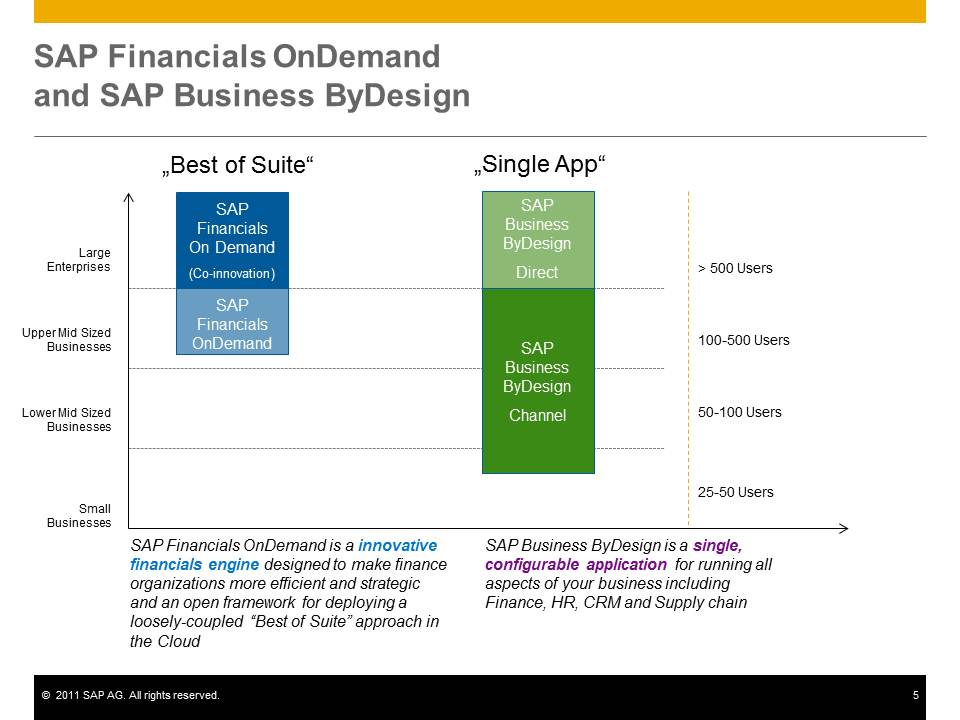
- SAP Community
- Products and Technology
- Technology
- Technology Blogs by SAP
- Positioning SAP Business ByDesign and SAP Financia...
- Subscribe to RSS Feed
- Mark as New
- Mark as Read
- Bookmark
- Subscribe
- Printer Friendly Page
- Report Inappropriate Content
Hi folks,
In the run-up to launching SAP Financials OnDemand, I've been getting daily questions on how to position SAP Business ByDesign relative to SAP Financials OnDemand. And, since I am the marketing manager for both products, I thought it might be a good idea to put out a short, and strongly simplified clarification around this.
Please take a look at the following visual, which explains the differences in a such a simplified format.

Simply stated, SAP Business ByDesign is a single application (or a "single app" in today's parlance) that customers can simply configure and use to run their entire business. This is specifically appropriate to the requirements of mid-size businesses, but also applies equally well to subsidiaries or divisions of larger enterprises, who want to buy only one application that does the job.
On the other hand we have our latest member of the Cloud Solutions family, SAP Financials OnDemand which we will fully launch at SAPPHIRE NOW in Madrid. This new solution is specifically designed to make finance organizations more efficient and to accelerate strategic execution. Finance OnDemand provides a trusted, single source of truth for the enterprise, while at the same time enabling instant action based on superior insight.
But SAP Financials on Demand is more that just a financials solution! It also provides an open and flexible framework that forms the foundation for a loosely-coupled "Best of Suite" approach for enterprises, seeking to mix and match the financial core with best of breed components. With Financials OnDemand, other cloud solutions, starting with SAP Travel OnDemand, simply snap-in using open API's to give customers a maximum of choice for building their own, personal best-of suite.
So, there you have it. SAP Business ByDesign is a single app that runs your entire business. And SAP Financials OnDemand is a cloud solution focussed on making the finance department more strategic.
Is there overlap between the solutions? Yes there is. The overlap cannot be avoided, because SAP Business ByDesign is using the same financial engine, and both products are available to large enterprises. But one can also look at the overlap from a benefits perspective. Both products are from SAP, and inherit 40 years of excellence in building financials solutions. Both solutions are engineered for the cloud, are fully multi-tenant and easily extensible using the same software development kit (SDK).
I hope this short blog helps to clarify the differences and similarities between SAP Financials OnDemand and SAP Business ByDesign. I look forward to your questions and comments.
CHHO, Walldorf, Oct 10, 2012
- SAP Managed Tags:
- SAP Business ByDesign,
- Cloud
You must be a registered user to add a comment. If you've already registered, sign in. Otherwise, register and sign in.
-
ABAP CDS Views - CDC (Change Data Capture)
2 -
AI
1 -
Analyze Workload Data
1 -
BTP
1 -
Business and IT Integration
2 -
Business application stu
1 -
Business Technology Platform
1 -
Business Trends
1,661 -
Business Trends
86 -
CAP
1 -
cf
1 -
Cloud Foundry
1 -
Confluent
1 -
Customer COE Basics and Fundamentals
1 -
Customer COE Latest and Greatest
3 -
Customer Data Browser app
1 -
Data Analysis Tool
1 -
data migration
1 -
data transfer
1 -
Datasphere
2 -
Event Information
1,400 -
Event Information
64 -
Expert
1 -
Expert Insights
178 -
Expert Insights
270 -
General
1 -
Google cloud
1 -
Google Next'24
1 -
Kafka
1 -
Life at SAP
784 -
Life at SAP
11 -
Migrate your Data App
1 -
MTA
1 -
Network Performance Analysis
1 -
NodeJS
1 -
PDF
1 -
POC
1 -
Product Updates
4,578 -
Product Updates
323 -
Replication Flow
1 -
RisewithSAP
1 -
SAP BTP
1 -
SAP BTP Cloud Foundry
1 -
SAP Cloud ALM
1 -
SAP Cloud Application Programming Model
1 -
SAP Datasphere
2 -
SAP S4HANA Cloud
1 -
SAP S4HANA Migration Cockpit
1 -
Technology Updates
6,886 -
Technology Updates
395 -
Workload Fluctuations
1
- Practical steps towards xP&A; lessons learned at FP&A trends board meet up in Technology Blogs by SAP
- Master data attribute recommendation using SAP AI Core and T5 transformers in Technology Blogs by Members
- BLOG SERIES | PARTNERS AND SAP CLOUD ALM | PART I: INTRO in Technology Blogs by SAP
- Summary of VIDEO SERIES “Boost your Planning with SAP IBP + SAP Analytics Cloud” in Technology Blogs by Members
- SMQ2, message no. SR053, "Invalid financial position for GR / IR clearing account line". in Technology Q&A
| User | Count |
|---|---|
| 11 | |
| 10 | |
| 10 | |
| 9 | |
| 8 | |
| 7 | |
| 7 | |
| 7 | |
| 7 | |
| 6 |